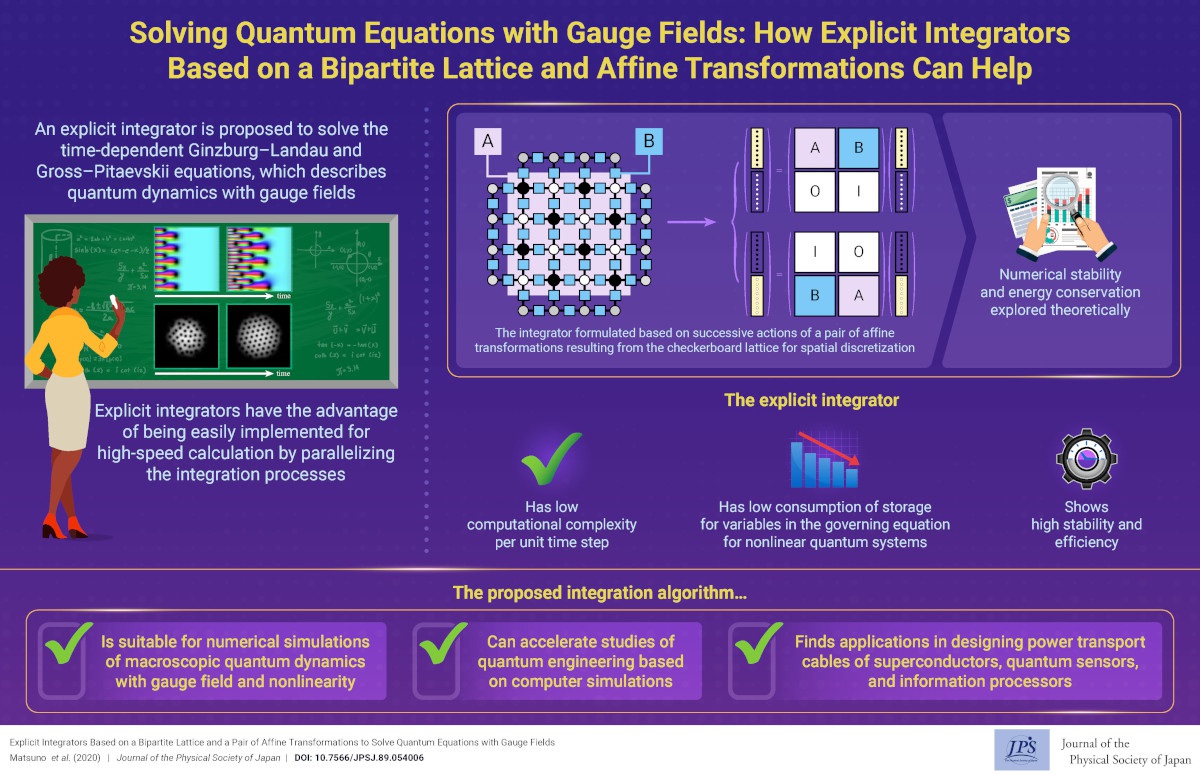Solving Quantum Equations with Gauge Fields: How Explicit Integrators Based on a Bipartite Lattice and Affine Transformations Can Help
© The Physical Society of Japan
This article is on
Explicit Integrators Based on a Bipartite Lattice and a Pair of Affine Transformations to Solve Quantum Equations with Gauge Fields
(JPSJ Editors' Choice)
J. Phys. Soc. Jpn. 89, 054006 (2020).
We proposed an explicit numerical integrator consisting of affine transformation pairs resulting from the checkerboard lattice for spatial discretization. It can efficiently solve time evolution equations that describe dynamical quantum phenomena under gauge fields, e.g., generation, motion, interaction of quantum vortices in superconductors or superfluids.
Explicit Integrators Based on a Bipartite Lattice and a Pair of Affine Transformations to Solve Quantum Equations with Gauge Fields
(JPSJ Editors' Choice)
J. Phys. Soc. Jpn. 89, 054006 (2020).
Share this topic
Fields
Related Articles
-
Exploring Electronic States in BEDT-TTF Organic Superconductors
Superconductivity
Electronic transport in condensed matter
Magnetic properties in condensed matter
2024-4-24
This review, published in the Journal of the Physical Society of Japan, provides a comprehensive summary of the electronic states observed in BEDT-TTF type organic superconductors, including metal-insulator transitions, Mottness transitions, non-Fermi liquids, quantum spin liquids, and Bose-Einstein condensation.
-
Quantum Mechanics of One-Dimensional Three-Body Contact Interactions
Mathematical methods, classical and quantum physics, relativity, gravitation, numerical simulation, computational modeling
Theoretical Particle Physics
2024-2-13
The quantum mechanical description of topologically nontrivial three-body contact interactions in one dimension is not well understood. This study explores the Hamiltonian description of these interactions using the path-integral formalism.
-
Exploring Recent Advances in the Physics of Biofluid Locomotion
Measurement, instrumentation, and techniques
Cross-disciplinary physics and related areas of science and technology
Electromagnetism, optics, acoustics, heat transfer, and classical and fluid mechanics
Statistical physics and thermodynamics
Mathematical methods, classical and quantum physics, relativity, gravitation, numerical simulation, computational modeling
Structure and mechanical and thermal properties in condensed matter
2023-12-8
This Special Topics Edition of the JPSJ describes the latest advances in the field of biofluid locomotion, shedding light on the underlying physics behind the movement of organisms that swim and fly.
-
A New Superconductor Family with Various Magnetic Elements
Superconductivity
Cross-disciplinary physics and related areas of science and technology
Electron states in condensed matter
2023-10-27
A new superconductor family, Sc6MTe2, has been discovered, comprising seven variations with magnetic elements labeled as M. Notably, only a few known superconductor families exist that involve various magnetic elements.
-
Exploring Vortex Dynamics in a Multi-band Superconductor
Superconductivity
2023-8-22
We measured the microwave flux-flow Hall effect in FeSe, where the cancellation of holes and electrons was observed. This is a novel effect of multi-band superconductors.

